Probably the largest manufacturer of early semiconductors in Europe was Philips of the Netherlands. As well as their own laboratory and manufacturing facilities in Eindhoven, Philips had three overseas subsidiaries:
- Mullard Ltd. in England.
- Valvo Gmbh. in Germany.
- La Radiotechnique in France.
Of these, Mullard was probably the largest in volume of semiconductors produced, although Valvo was not far behind. Devices from La Radiotechnique are much rarer than those of the other two. In the USA, Philips devices were marketed through another subsidiary: Amperex, although they were almost all marked “MADE IN HOLLAND”.
Philips seems to have operated as quite a loose federation of companies, with all of the above potentially doing research that resulted in new devices. However, with only a few early exceptions, all devices followed a common naming convention and all the subsidiaries marketed and sold the full Philips range.
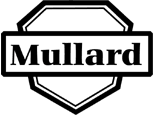
Mullard Limited was founded by Captain S.R. Mullard in 1920 to manufacturer high-power transmitting valves for the British Admiralty. (For American readers, I had better explain that in Britain an electronic ‘valve’ is what you call a ‘vacuum tube’). His business prospered and in 1924 he raised capital by selling half the company to Philips, who bought the rest in 1927. Wholly owned by Philips, Mullard Ltd. went on to become a major manufacturer of valves and associated components.
When the transistor was announced by Bell Labs in 1948, two UK companies were not far behind in research terms, STC and GEC. Mullard had no semiconductor research laboratory as far as I know, and I suspect that Philips also had done little work in the field. However, a former Mullard employee told me that Philips made the decision in about 1950 to start manufacturing transistors, with the goal of capturing 95% of the European market. I do not have statistics, but the Mullard brand certainly became dominant very quickly, and remained so for nearly twenty years.
Mullard’s original manufacturing facilities were in Mitcham, and their head office remained in London, but their semiconductor production moved to a purpose-built plant in Southampton in 1957. A description of the site’s history is available on the Web (14.8 MB pdf file!).
Philips/Mullard’s original semiconductor product lines were the OC series of germanium transistors and the OA and OAZ series of germanium diodes. They moved on to use many Pro Electron prefixes such as AA, AC, AD, AF, ASY, ASZ, and AUY. Eventually they manufactured silicon types with prefixes BA, BC etc. The OC series was very widely used in Europe for a period of almost twenty years and many millions were made. Other companies such as Tungsram, Intermetall and Telefunken made their own OC types.
True Mullard devices usually bear the name MULLARD in capitals, the type number e.g. OC71, and an indication of the place of manufacture, usually either “GREAT BRITAIN”, which signifies made in a British factory, or “BRITISH MADE”, which means made elsewhere in the then British Empire. This information was sent by a correspondent who also included a long list of Mullard factories in many countries. Occasional examples can be found that are marked “MADE IN HOLLAND”, which I believe indicates a Philips factory, and very rarely “MADE IN FRANCE”. Examples can also be found that bear no manufacturer’s name or place of origin, I believe these to be made by Philips in the Netherlands. They usually have a code printed on them, composed of a small number of mixed-case letters and numbers. I do not know how to decode this, or even whether it is a date code or something else. If you can help, please contact me.
You may come across vintage GEC (UK) transistors and diodes bearing the Mullard name. This because, in 1962, GEC merged its semiconductor interests with those of Mullard Ltd., to form a joint venture called Associated Semiconductor Manufacturers (ASM). Devices were marketed through Mullard, and so GEC devices can be found bearing the Mullard name. In fact, ex-GEC employees have told me that the ‘joint venture’ was a takeover by Mullard in all but name.
I do not possess all the transistors below, in fact I am seeking many of them. It is noted in the text where I am seeking examples of any particular type. If you have some for sale or exchange, please contact me.
Conversely, I am happy to help anyone looking for information on these devices. I have an extensive collection of original data sheets and books, and can provide characteristic data on almost all OC series types.
| The first transistors made by Mullard were the OC50 and OC51 point-contact types from 1952. As this image of the OC51 shows, they looked just like a typical Bell Labs “outline #1” case, except that the metal is shinier, and the plastic plug in which the leads are fixed is pale brown. I have three of them and only one has any markings on it, suggesting that the white printing rubs off the black band very easily. These transistors were probably not commercially available: some were probably given to a few research institutes, then Mullard rapidly moved on to junction types.
I am seeking examples of the OC50, and indeed of the OC51 in identifiable form, for example in an original box. I also wish to buy original data sheets for these devices. If you have any of these, please contact me. |
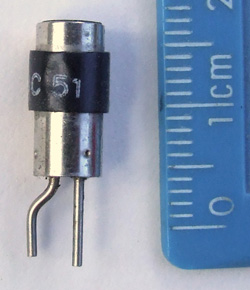 |
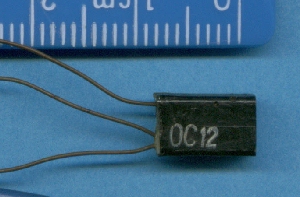 |
The first (grown?) junction types made by Mullard were the OC10, OC11, and OC12 (shown in the image) from 1953. These were all low-power audio-frequency amplifiers, the first two differing in noise level, the OC12 having a higher gain. Unfortunately, it was soon found that the plastic encapsulation was not hermetic, and moisture crept along the leads and ruined the transistors.
I am seeking examples of the OC10, OC11 and OC12. I also wish to buy original data sheets for these devices. If you have any of these, please contact me. |
| Mullard then developed a unique glass encapsulation, and in 1954 issued three new alloy-junction audio-frequency transistors, the OC70, OC71 and OC72. The image shows the OC71 glass case, painted black, with below it the OC72, a higher power type, achieved by slipping an aluminium can over the glass tube. The OC70 was a low-noise version of the OC71.
This black glass encapsulation, and the version with the aluminium sleeve, both referred to as SO-2, were used by most of the transistor types in the OC series, although a few types used the TO-7 metal can, and power types used TO-3. A correspondent told me that in the early days of the industry, an apprentice at his company was sacked because he had amused himself by crunching the glass capsules under his boot. At the time each transistor cost a week’s wages! |
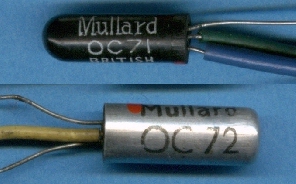 |
| Examples of transistors branded ASM are rare, especially early types. This OC72 is the only such type I have found. | 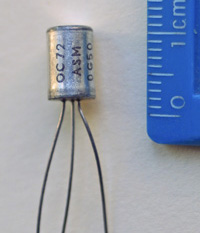 |
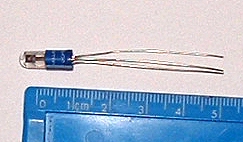 |
Like other manufacturers, Mullard produced a phototransistor, the OCP71 shown on the left. This is a very early type, available commercially from 1956. It is well-known that semiconductor junctions can be light-sensitive, and there is a widely repeated story that the OCP71 was just an ordinary OC71 without the black paint (so-called ‘dope’). Because the OCP71 was more expensive, some people just scraped the paint off an OC71, to create an equivalent to the OCP71. The story then claims that Mullard changed the filler in the capsules from clear to opaque, to prevent this practice.
Thanks to correspondence with an ex-Mullard employee from the Mitcham works, I now know that this story is entirely wrong. At the time, the behaviour of manufactured transistors varied considerably, so devices from one production line were sorted into either OC70, OC71, or OC75 using a Transistor Test Board to measure their performance. These transistors were dipped in a light blue silicon “Bouncing” putty before insertion into the glass capsule which was then filled with Alundum paste: an aluminium oxide and silicon oil mix that was lightproof and also conducted heat away from the transistor junctions. The exterior was painted with a black ‘dope’. Scraping off the black dope therefore reveals a blue tinged whitish interior. However, the OCP71 capsules were filled instead with a clear silicon grease to allow light through. They were tested as phototransistors and those that were rejected were re-tested to see if they met the normal OC7x series parameters. Those that did were sent off to be painted with the black dope and be printed as OC7x devices before being packaged as normal. Therefore, if scraping the paint off an OC71 reveals a transparent interior, this is NOT an early example before Mullard switched the filler, but is in fact a rejected OCP71. Using it as a phototransistor is not a good idea! There exist also OCP70 phototransistors in the same style, an unpainted capsule in a plastic holder. However my experience is that they are invariably unbranded, unlike the OCP71 which is usually marked ‘MULLARD’. I suspect this means that they are generic Philips devices for OEM use. If anyone can confirm this, or has an OCP70 marked Mullard (not an OCP71), please contact me. |
| Philips/Mullard produced the first commercial high-power transistor in Europe, the OC16, in about 1956. The prototype version on the left in the image handles 24 Watts. The commercial version to its right used a different stud packaging in which two leads emerged through a hole in the centre of the fixing screw. This package was only used for the OC16, apart from two exceptions that I know: I have a single OC24 in this package (normally that device uses the TO-3 package), and I possess a strange Mullard type CXT6b, shown below. | 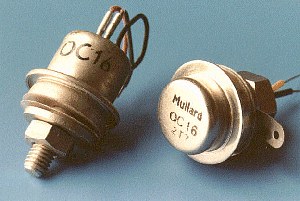 |
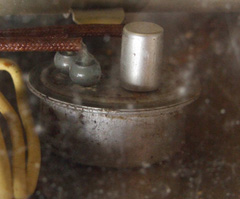 |
However, there was an even earlier Philips prototype power transistor that is exceedingly rare: the OC15. My image of it is rather unclear because it was taken through a perspex sheet. The transistor is part of a demonstration transistor amplifier in a perspex and metal case, probably made for a trade show in the 1950s. It contains two OC71’s, two hefty interstage transformers, and a single OC15. The OC15 should have a paper label but that has fallen off and is trapped in the wiring. I have not yet attempted to open the perspex casing.
This device was probably developed by Valvo in Germany, who originally numbered it 100.O.C. Amperex in the USA numbered it 2N115, although they also used the same number on later OC16 devices. Images of these variants can be seen on Joe Knight’s pages on Jack Ward’s web site. |
| Mullard soon abandoned the proprietary stud encapsulation for high-power transistors, and changed to using the standard TO-3 ‘diamond’ package, as shown in this OC19, another audio-frequency type from about 1962. At this time, Mullard were still supplying their transistors in the same kind of cartons that they used for valves. | 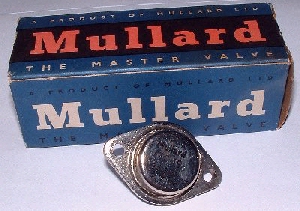 |
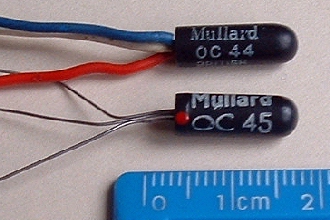 |
Also in 1956, Mullard announced the OC44 and OC45 transistors, the latter seems to be described all over the Web as “the first RF transistor”, although I think this only applies to Europe. In reality these two devices would be more accurately termed IF transistors. There is an ongoing market for the OC45 on eBay because it was used in some early guitar effects units (“fuzz boxes”) and purists insist that only the original will do. There are even people who talk about the “germanium sound”, and do not mean poor signal-to-noise ratio! |
| Like other manufacturers, Mullard believed that hearing aids provided an early application for the transistor, because of its small size, low voltage, and lack of heater circuit compared to valves/tubes. This was ultimately only a minor market, but Mullard created four sub-miniature types, OC57 to OC60, only a few millimetres long, and two miniature types OC65 and OC66, slightly larger. All were audio-frequency amplifiers for use in the output stages of hearing aids. | 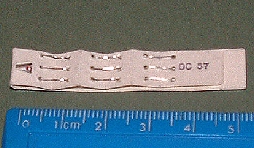 |
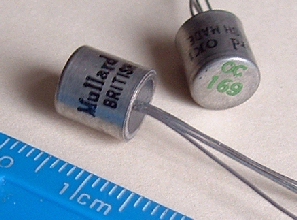 |
The first RF transistors used the alloy-junction fabrication process, which limited their upper-frequency limit. Mullard soon followed the American lead in improving upon this with a technique called alloy-drift, where controlled doping gradients were used. Their first examples were the OC169 (shown) to OC171 in 1959, but later their AF114 to AF118 types from 1961 onwards, using the same TO-7 metal can with shield lead, became standard in the RF stages of British transistor radios.
Unfortunately for vintage radio enthusiasts, many of these TO-7 types showed problems over time, and various very ad-hoc cures were attempted. Investigation by NASA Goddard has now shown that the problem is tin whiskers growing out from the interior walls of the can, ultimately touching the germanium die and shorting it out. |
| Mullard made a small number of devices that were intended as driver transistors for audio output stages. These bore the suffix ‘D’, and examples include OC78D, OC81D, and OC82D. For reasons unknown to me, these types often used the SO-2 glass capsule but with a coloured plastic sleeve, rather then being painted black. This is occasionally seen on other types too.
If anyone can explain this, please contact me. |
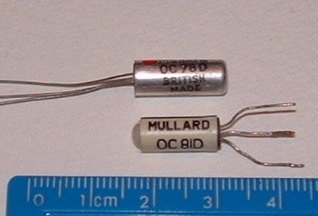 |
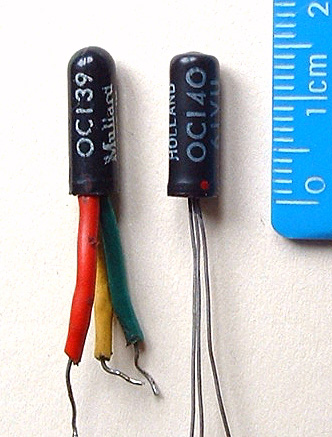 |
Of course, Mullard also produced switching transistors for use in computers and logic circuits. In 1959 they announced a number of these, including the OC41 and OC42 in the SO-2 metal can, and the rather unusual OC139 to OC141 which are germanium NPN types in the SO-2 glass package, usually marked “MADE IN HOLLAND”. All of these devices found widespread use in the UK electronics industry, including computer manufacture. |
| Mullard’s first silicon transistors were the OC201 to OC207, PNP alloy types using the standard SO-2 metal-over-glass construction such as the OC201 shown. These can occasionally be found on eBay, usually advertised as germanium devices! Mullard soon switched to using the BC prefix for silicon, and AC for germanium, eliminating the confusion. Only a few of the BC types are found in the SO-2 metal packaging, such as the BCZ10 shown, most used newer plastic encapsulation. |
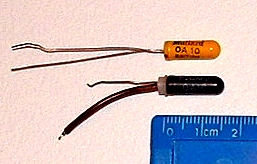 |
Of course, Mullard made diodes as well as transistors, and their OA series found widespread use. They made point-contact, gold-bonded, and junction types, plus Zeners, in both germanium and silicon,. This included subminature axial types, miniature axial types such as the OA81 often used as the AF detector in radio circuits, and switching types like the OA10 in the SO-2 glass package. Most of these diodes were painted black, but sometimes yellow was used. Later types used the AA (germanium) and BA (silicon) prefixes in their part numbers. Zeners had a ‘Z’ in the prefix, e.g., OAZ205. |
| This device is in the same primitive stud package with leads out of the top used for the prototype OC16 in about 1955. Disintegrating greased paper labels are marked “Semiconductor Lab. Development Sample. No guarantee for subsequent delivery.” The label should bear an added written type number, but this is either missing or too faint. | 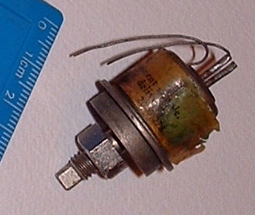 |
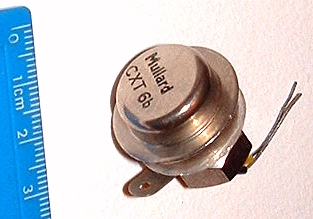 |
This transistor CXT6b is a real puzzle. It is in the stud package used for the commercial OC16, the first Mullard power transistor, which suggests that it dates from about 1956. The only information that I have unearthed is that the 1963 CV Register of Electronic Valves mentions two GPO types, CXT1 and CXT2, with CV equivalents. This suggests that this CXT6b may be a GPO type, probably equivalent to OC16. However, GPO types are usually found in the PO series, itself rare.
If anyone knows about this device or the CXT series, please contact me. |
| There are other unusual Mullard types that I possess, but for which I have no data despite possessing many Mullard books and datasheets spanning the whole germanium period. These include type MEI (or possibly ME1) in the SO2 black glass tube but with red and white rubber bands around it, type NC11 in the SO2 metal can, type T1 in the SO2 black glass tube, type T3 in a TO-7 can, type T4 in a TO-1 can, a dual-typed OC16 also marked 2N115, and a type 2N583K in the typical GEC copper can with blue sleeve.
If you know about any of these devices, please contact me. |
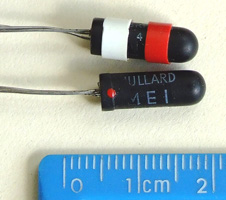 |
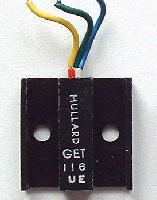 |
This GET116 is an example of a vintage GEC (UK) transistor bearing the Mullard name. This means that it post-dates the creation of ASM, after which GEC branding gradually disappeared. This is borned out by the date code UE which stands for May 1963. |
| Like most UK semiconductor manufacturers, Mullard made CV equivalents of many of their devices. These were military-grade versions of commercial types, given a Common Valve type designation such as those shown. | 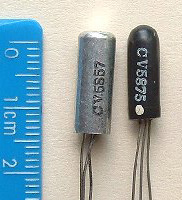 |
©2018 Andrew Wylie all rights reserved
http://www.wylie.org.uk/technology/semics/Mullard/Mullard.htm










